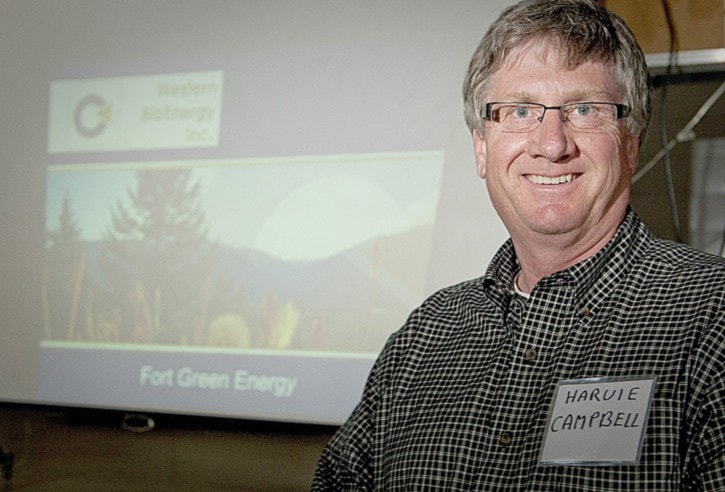It’s all in the wood.
New projects could help bring stability to the forest sector in north-central B.C., using wood biomass now being burned along roadsides or in beehive burners.
Western BioEnergy Inc. is awaiting a decision on their proposed BC BioEnergy Network which would include three biomass-fired, electricity generating stations, one in Burns Lake, one in Merritt and one in Fort St. James.
The three projects have been short-listed by BC Hydro, and are now awaiting the completion of a review of BC Hydro currently underway.
“It’s not finalized, but we’re optimistic,” said Western BioEnergy Director Harvie Campbell.
Conifex Timber is also investing $50 million into a bioenergy plant at its Mackenzie operation which will power their mill using wood waste to produce electricity.
In addition, a biofuel plant is being proposed for Houston, which would use wood waste to produce gas, something Nechako Lakes MLA John Rustad said could “change the face of forestry.”
All of these plants would use the wood now either left in the bush, piled and burned on clearcuts or waste from mills still burned in beehive burners.
This would also be facilitated by a new licencing program the B.C. government has come up with called a “receiving licence” which allows allows the licensee to transfer the volume of waste wood as biomass to the plants, so the volume does not count against their permit.
Western BioEnergy Inc held an information session recently in Fort St. James at Kwah Hall to answer questions from the community and explain the local part of their proposed BC BioEnergy Network project.
The Fort St. James biomass power plant would be located 6.3 km north of town, across from the Apollo mill on a small 3.5 hectare site.
The Fort plant would be an estimated investment of $140 million, with approximately 80 employed during construction and 16 employed directly while the plant is in operation, as well as local contractors required for some aspects of the plant maintenance.
There will also be jobs associated with the fibre supply, bringing the required fibre fuel to the plant, which Campbell estimates at 30 to 60, depending on whether the fibre supply is coming from the mills or from direct harvesting activities.
All of the on-site positions will eventually be local positions, with initial hires potentially coming from different areas to obtain the required skills, but eventually these jobs will be local, especially with the training and apprenticeship programs they will be initiating.
The project has a lifespan of 30 years, but could be operated as long as it is maintained and viable.
The plant would give a boost to local forestry economics, according to Campbell, because wood which currently has no value to the logging companies would instead have value by selling it to the plant.
Additionally, even if there was a downturn in the lumber market and mills shut down, the plant would help maintain some stability in harvesting as they would still need to maintain a fiber supply, regardless of the mill demand.
“The whole economics of sawmills would stabilize,” said Campbell.
The benefits go beyond economics as well, since it would be worthwhile bringing the excess out of the bush, air quality in the area would also benefit because there would be no need for roadside burning.
As well, while beehive burners are supposedly being phased out, the local mills do sometimes still burn waste in these when needed, which is also much less efficient and produces more particulates and air pollution.
Campbell also promised the community would be able to recycle household wood waste, which they could then use in the plant.
All three proposed biomass generators would use the same technology and basic design in the Fort, Burns Lake and Merritt, and would each produce 33 MW of electricity and use about 200,000 dry tonnes of forest residue per year.
With the biomass being stored in a building, and most of the plant enclosed, the design should keep noise and dust to a minimum, and an electrostatic precipitator would help capture particulates from the exhaust, producing very low emissions, one-onehundredth the emissions produced by the beehive burners.
The plant is also designed to be air-cooled, reducing the water usage, and eliminating the steam plume from older water-cooled bioenergy plants.
The local site would power the entire Fort community, using about 50 per cent of the plant’s electricity, with the rest going down into the grid towards Vanderhoof. The plant would be connected to the grid using a short 300 m 69 kV transmission line.
Negotiations with First Nations groups in the area are in their initial stages, with an offer of 10 per cent equity position in the project and preferred status in providing fibre supply and fibre supply contracting as well as employment with training and apprenticeship programs.
Nak’azdli, Tl’az’ten and Takla are working together in discussions with BioEnergy, according to Campbell, and Yeekoochi may join later.
“I think we would welcome something as long as we’re involved in the partnership,” said Nak’azdli Chief Fred Sam. “If it’s feasible then we want to be involved.”
If approved by BC Hydro, pending an agreement with First Nations and timber supply licences, construction could begin in the spring of 2012, expected to be completed by the spring of 2014 when operation could then begin.
Western BioEnergy Inc is owned by Dalkia Canada, a Canadian subsidiary of Dalkis International, which is a Paris-based energy company, which has extensive experience in developing these types of projects, according to Campbell.
